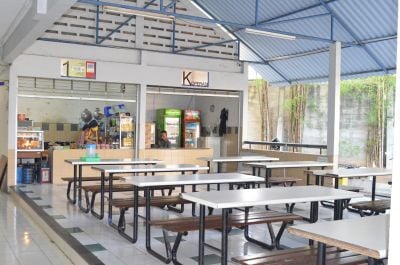How to reduce waste at school canteen? Post your comments here or propose a question.
Difference between revisions of "Biography of Antonio Maria Blanco"
| Line 2: | Line 2: | ||
|Full Name=Antonio Maria Blanco | |Full Name=Antonio Maria Blanco | ||
|Pen Name=Sang Maestro | |Pen Name=Sang Maestro | ||
| + | |Photograph=AntonioMarioBlanco.jpg | ||
|Link photo=http://www.blancomuseum.com/ | |Link photo=http://www.blancomuseum.com/ | ||
|Biography text=Antonio Blanco was born on September 15, 1911, in Manila, the capital of the Philippines. Both of his parents were Spanish, a fact that Blanco believed linked him geographically and spiritually to Miro and Salvador Dali. His father settled in Manila during the Spanish - American War, where he attained prominence as a physician. Blanco was educated at the American Central School in Manila. During his high school years he loved the arts, literature and language classes but struggled in scientific subjects. It is no wonder that he spoke six languages - Spanish, French, English, Tagalog, Indonesian and a bit of Balinese. After completing high school in Manila, Blanco studied at the National Academy of Art in New York under Sidney Dickinson. During those early formative years, Blanco concentrated on the human form, fascinated by the female body more than any other subject matter. To further his studies and ignite his traveling spirit, he traveled extensively throughout the world before he finally landed in Bali in 1952. The King of Ubud gave Blanco a piece of land to set up his home and studio in Campuan, Ubud, at the confluence of two sacred rivers. Blanco and his Balinese wife, the celebrated dancer Ni Ronji, lived in their mountain retreat, barely leaving it for the world outside. Following a brief trip to the United States, where Blanco acquired many new collectors, the couple never left their fantasy home again. | |Biography text=Antonio Blanco was born on September 15, 1911, in Manila, the capital of the Philippines. Both of his parents were Spanish, a fact that Blanco believed linked him geographically and spiritually to Miro and Salvador Dali. His father settled in Manila during the Spanish - American War, where he attained prominence as a physician. Blanco was educated at the American Central School in Manila. During his high school years he loved the arts, literature and language classes but struggled in scientific subjects. It is no wonder that he spoke six languages - Spanish, French, English, Tagalog, Indonesian and a bit of Balinese. After completing high school in Manila, Blanco studied at the National Academy of Art in New York under Sidney Dickinson. During those early formative years, Blanco concentrated on the human form, fascinated by the female body more than any other subject matter. To further his studies and ignite his traveling spirit, he traveled extensively throughout the world before he finally landed in Bali in 1952. The King of Ubud gave Blanco a piece of land to set up his home and studio in Campuan, Ubud, at the confluence of two sacred rivers. Blanco and his Balinese wife, the celebrated dancer Ni Ronji, lived in their mountain retreat, barely leaving it for the world outside. Following a brief trip to the United States, where Blanco acquired many new collectors, the couple never left their fantasy home again. | ||
| Line 22: | Line 23: | ||
|Description of work=The legend of Cinderella is found in many forms all over the world. Here is my version: There are four girls; three are very ugly and egotistical. The Step Mother hates Cinderella, the fourth girl, and harasses her constantly. Cinderella finally leaves home and, when she reaches the mountains, Magic Birds befriend her and shower her with gifts of gold, diamonds and love. This legend ends with a Handsome Prince marrying Cinderella and they live happily ever after. | |Description of work=The legend of Cinderella is found in many forms all over the world. Here is my version: There are four girls; three are very ugly and egotistical. The Step Mother hates Cinderella, the fourth girl, and harasses her constantly. Cinderella finally leaves home and, when she reaches the mountains, Magic Birds befriend her and shower her with gifts of gold, diamonds and love. This legend ends with a Handsome Prince marrying Cinderella and they live happily ever after. | ||
|Description of work id=Terdapat berbagai versi cerita legenda Cinderella diberbagai penjuru dunia. Ini versiku: Ada empat gadis, yang tiga buruk rupa dan hati. Sang ibu tiri membenci Cinderella, gadis keempat, selalu mengejek dan menyusahkannya. Akhirnya Cinderella meninggalkan rumah dan saat ia sampai di gunung, seekor burung ajaib menemaninya dan memberikan banyak hadiah emas, permata, dan cinta. Legenda ini berujung dengan seorang pengeran rupawan menikahi Cinderella dan mereka hidup bahagia selamanya. | |Description of work id=Terdapat berbagai versi cerita legenda Cinderella diberbagai penjuru dunia. Ini versiku: Ada empat gadis, yang tiga buruk rupa dan hati. Sang ibu tiri membenci Cinderella, gadis keempat, selalu mengejek dan menyusahkannya. Akhirnya Cinderella meninggalkan rumah dan saat ia sampai di gunung, seekor burung ajaib menemaninya dan memberikan banyak hadiah emas, permata, dan cinta. Legenda ini berujung dengan seorang pengeran rupawan menikahi Cinderella dan mereka hidup bahagia selamanya. | ||
| − | |Photo of work= | + | |Photo of work=File:NiBawang.jpg |
|Link=http://blancomuseum.com/ | |Link=http://blancomuseum.com/ | ||
}} | }} | ||
}} | }} | ||
Revision as of 08:30, 18 March 2018
- Full Name
- Antonio Maria Blanco
- Pen Name
- Sang Maestro
- Photograph by
- Link to Photograph
- http://www.blancomuseum.com/
- Website for biography
- Place
- Related Music
- Related Books
- Related Scholars Articles
Biography
In English
In Balinese
In Indonesian
Examples of work
Ni Bawang (The Cinderella of Bali) Oil on canvas (around 1964) Collection of the Blanco Museum



Enable comment auto-refresher